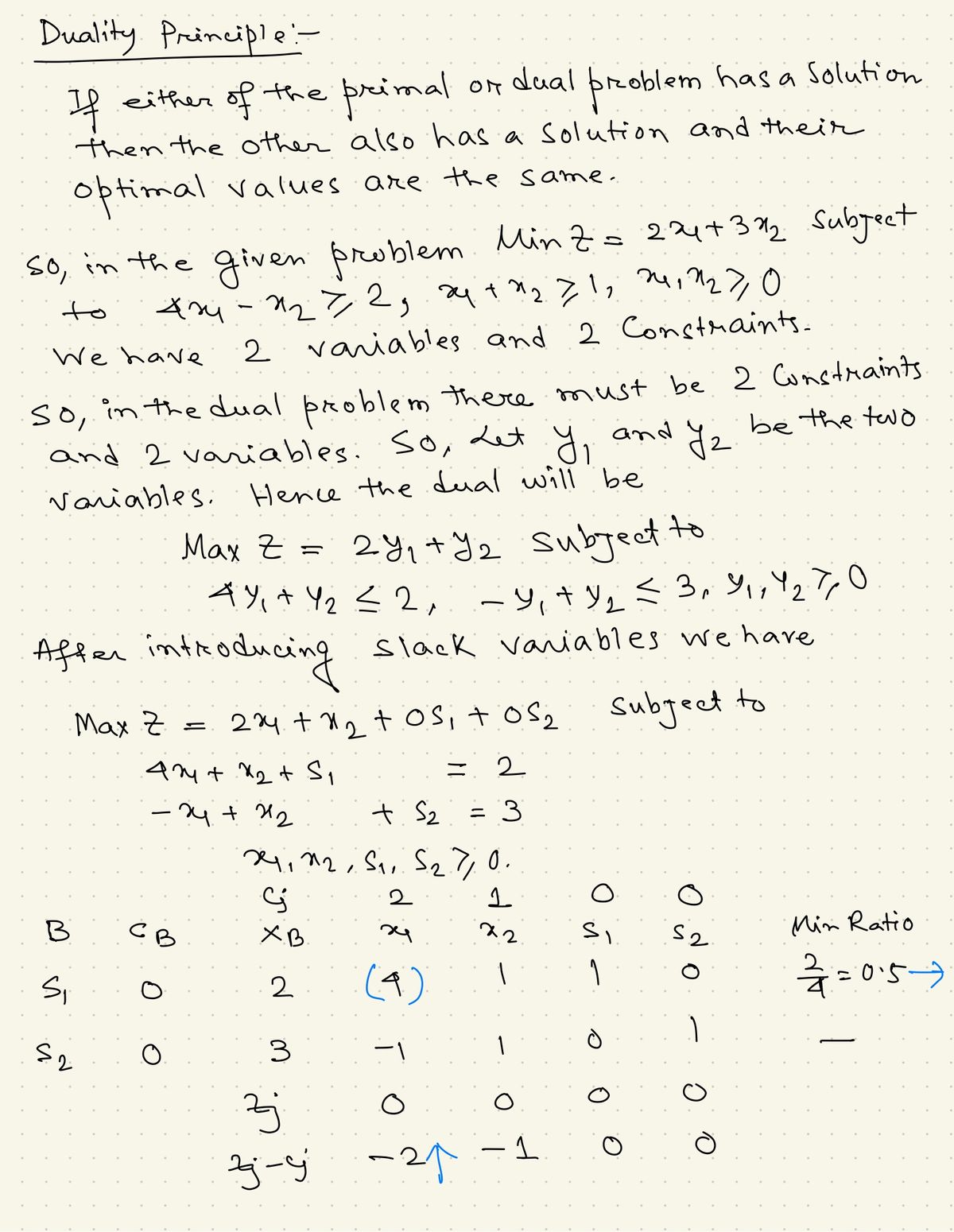Use the simplex method and the Duality Principle to solve the following minimum problem: (see image below) and using your final tableau answer the questions below by entering the correct answer in each blank box.
Use the simplex method and the Duality Principle to solve the following minimum problem: (see image below) and using your final tableau answer the questions below by entering the correct answer in each blank box.
Advanced Engineering Mathematics
10th Edition
ISBN:9780470458365
Author:Erwin Kreyszig
Publisher:Erwin Kreyszig
Chapter2: Second-order Linear Odes
Section: Chapter Questions
Problem 1RQ
Related questions
Question
Use the simplex method and the Duality Principle to solve the following minimum problem: (see image below)
and using your final tableau answer the questions below by entering the correct answer in each blank box.
![### Problem Statement
**Objective:**
Minimize the function: \( C = 2x_1 + 3x_2 \)
**Subject to the constraints:**
\[
\begin{align*}
4x_1 - x_2 & \geq 2 \\
x_1 + x_2 & \geq 1 \\
x_1 & \geq 0 \\
x_2 & \geq 0
\end{align*}
\]
### Explanation:
- **Objective Function**: The function \( C = 2x_1 + 3x_2 \) is the expression to be minimized.
- **Constraints**: These inequalities restrict the values of \( x_1 \) and \( x_2 \) to feasible solutions that satisfy all conditions.
- The first inequality \( 4x_1 - x_2 \geq 2 \) represents a linear constraint.
- The second inequality \( x_1 + x_2 \geq 1 \) is another linear constraint.
- The last two constraints \( x_1 \geq 0 \) and \( x_2 \geq 0 \) ensure that the variables are non-negative, which is typical in linear programming problems.
**Note**: The problem can be graphically interpreted by plotting the constraints on a Cartesian plane, where the feasible region will be the intersection of all half-planes represented by the inequalities. The optimal solution will be found at a vertex (corner point) of this feasible region.](/v2/_next/image?url=https%3A%2F%2Fcontent.bartleby.com%2Fqna-images%2Fquestion%2Ffa413bcf-f4d4-4563-8c5c-bfbbe2a7d62c%2Feb879c18-22ae-48f7-a231-22480bb0a2a3%2Fijmohcm_processed.png&w=3840&q=75)
Transcribed Image Text:### Problem Statement
**Objective:**
Minimize the function: \( C = 2x_1 + 3x_2 \)
**Subject to the constraints:**
\[
\begin{align*}
4x_1 - x_2 & \geq 2 \\
x_1 + x_2 & \geq 1 \\
x_1 & \geq 0 \\
x_2 & \geq 0
\end{align*}
\]
### Explanation:
- **Objective Function**: The function \( C = 2x_1 + 3x_2 \) is the expression to be minimized.
- **Constraints**: These inequalities restrict the values of \( x_1 \) and \( x_2 \) to feasible solutions that satisfy all conditions.
- The first inequality \( 4x_1 - x_2 \geq 2 \) represents a linear constraint.
- The second inequality \( x_1 + x_2 \geq 1 \) is another linear constraint.
- The last two constraints \( x_1 \geq 0 \) and \( x_2 \geq 0 \) ensure that the variables are non-negative, which is typical in linear programming problems.
**Note**: The problem can be graphically interpreted by plotting the constraints on a Cartesian plane, where the feasible region will be the intersection of all half-planes represented by the inequalities. The optimal solution will be found at a vertex (corner point) of this feasible region.
Expert Solution
Step 1: Formulating the solution

Step by step
Solved in 3 steps with 3 images

Recommended textbooks for you

Advanced Engineering Mathematics
Advanced Math
ISBN:
9780470458365
Author:
Erwin Kreyszig
Publisher:
Wiley, John & Sons, Incorporated

Numerical Methods for Engineers
Advanced Math
ISBN:
9780073397924
Author:
Steven C. Chapra Dr., Raymond P. Canale
Publisher:
McGraw-Hill Education

Introductory Mathematics for Engineering Applicat…
Advanced Math
ISBN:
9781118141809
Author:
Nathan Klingbeil
Publisher:
WILEY

Advanced Engineering Mathematics
Advanced Math
ISBN:
9780470458365
Author:
Erwin Kreyszig
Publisher:
Wiley, John & Sons, Incorporated

Numerical Methods for Engineers
Advanced Math
ISBN:
9780073397924
Author:
Steven C. Chapra Dr., Raymond P. Canale
Publisher:
McGraw-Hill Education

Introductory Mathematics for Engineering Applicat…
Advanced Math
ISBN:
9781118141809
Author:
Nathan Klingbeil
Publisher:
WILEY

Mathematics For Machine Technology
Advanced Math
ISBN:
9781337798310
Author:
Peterson, John.
Publisher:
Cengage Learning,

